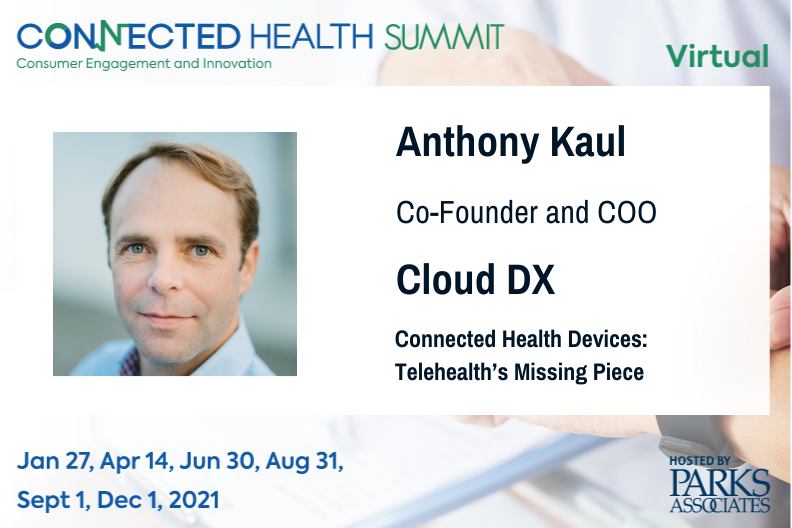 Parks Associates kicks off its 2021 virtual Connected Health Summit this week with its first session on January 27, New Connected Health Use Cases: Impact of COVID-19. COVID-19 has turned the healthcare industry on its head, moving the focal point of care away from the care facility and into the home. Ahead of the session, Anthony Kaul, Co-Founder and COO of Cloud DX, shared his thoughts with us on the the multi-layered impact COVID-19 has had on the connected health market:
Parks Associates kicks off its 2021 virtual Connected Health Summit this week with its first session on January 27, New Connected Health Use Cases: Impact of COVID-19. COVID-19 has turned the healthcare industry on its head, moving the focal point of care away from the care facility and into the home. Ahead of the session, Anthony Kaul, Co-Founder and COO of Cloud DX, shared his thoughts with us on the the multi-layered impact COVID-19 has had on the connected health market:
How has COVID-19 impacted the connected health market?
The impact has been vast. In terms of Virtual Care, the pandemic has normalized to a large degree seeing your doctor remotely through virtual visits and video telemedicine. It has made both clinicians and patients more comfortable with using connected technology as a conduit for care. We have seen a sharp and sustained rise in deployments for Chronic Disease Management using Remote Patient Monitoring for complex primary diseases like COPD, CHF and Diabetes. Likewise reducing post-surgical hospitalizations and discharging patients sooner with a Connected Health Kit has proven to be wildly successful. Both of these use cases keep have been effective for keeping at risk patients out of hospital and safer during COVID, but they have proven themselves to improve outcomes and reduce costs regardless of the pandemic and will continue. COVID virtual outpatient monitoring has proven to be extremely successful in reducing the burden on acute care settings while improving care and reducing costs substantially in Hospitals in Canada and the US. We are keen to see these positive effects continue after the bulk of the crisis is over.
Will shifts in consumer behaviors related to fitness, wellness, chronic care management, and care for senior populations outlast the COVID-19 crisis? How can solution providers keep consumers engaged over the long-term?
Not surprisingly, we have found that patient engagement is directly linked to benefit received. Remote Patient Monitoring with Cloud DX has near 100% patient satisfaction scores and a Clinician NPS of 83%. Better outcomes for the patient – fewer hospitalizations and ED visits, less unbillable time from the clinician point of view with improved operational efficiencies and lower costs for the payer will drive continued and sustained interest in Connected Health.
Keeping consumers engaged comes down to focusing on compliance at the beginning to develop the self-sustaining feedback loops that provide value and benefit for the patient. One of our superpowers is compliance as a foundation of a successful deployment. In our experience compliance breeds engagement not the other way around.
COVID-19 exposed the vulnerability of our senior population – how can independent living solutions best meet the needs of seniors and caregivers?
We need more data on these populations. We need to be able to stratify risk in long-term care homes to efficiently and effectively coordinate care for the most at risk. Monitoring seniors vital signs and setting baselines would allow us insight into this risk stratification so resources can be properly deployed.
Keeping seniors in their own homes longer by using Connected Health where possible reduces costs and improves satisfaction and outcomes. This can also reduce the level of exposure to COVID and other communicable diseases for these patients.
The healthcare economy has been severely disrupted in this crisis, but regulations and reimbursement for connected health solutions are trending positive – how will these competing forces impact the growth of the connected health market?
Connected health, when properly deployed reduces costs for the payer (Gov’t or Private) while improving outcomes for the patient. It allows clinicians to manage larger patient populations more efficiently, stabilize billings and increase throughput. I do not think these forces are in competition. Embracing connected health truly accomplishes the quadruple aim of Healthcare.
Join us this year for our Connected Health Summit! Register now.


